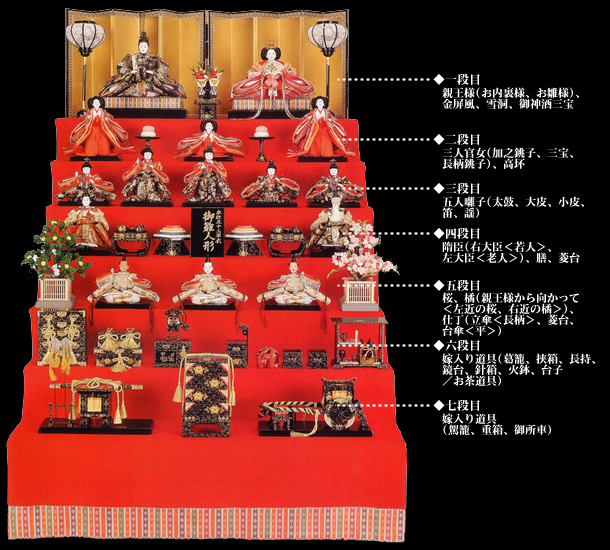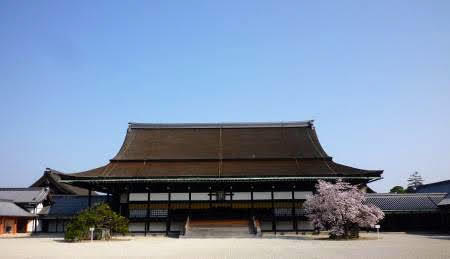
The way Hina Dolls are displayed varies depending on the period and region so there is no one way to do it, but we will introduce some common ways to display them.
− Example of a Standard Tiered Display (Seven Tiers)

| 一段目 | 親王様(お内裏様、お雛様)、金屏風、雪洞、御神酒三宝 |
|---|---|
| 二段目 | 三人官女(加之銚子:くわえのちょうし、三宝:さんぽう、長柄銚子:ながえのちょうし)、高坏 |
| 三段目 | 五人囃子(太鼓:たいこ、大皮:おおかわ、小皮:こかわ、笛:ふえ、謡:うたい) |
| 四段目 | 隋臣(右大臣<若人>、左大臣<老人>)、膳、菱台 |
| 五段目 | 桜、橘(親王様から向かって<左近の桜、右近の橘>)、仕丁(立傘<長柄>、菱台、台傘<平>) |
| 六段目 | 嫁入り道具(葛籠、挟箱、長持、鏡台、針箱、火鉢、台子/お茶道具) |
| 七段目 | 嫁入り道具(駕籠、重箱、御所車) |
− When Displaying Old-fashioned Hina Dolls
Hina Dolls are traditionally displayed during Hinamatsuri each year to ward off misfortune for as long as the owner is alive.
If the family includes a grandmother, mother, female baby, and other girls, then the dolls are decorated together with a focus on the baby’s Hina Dolls.
− Direction and Location When Displaying
In general, it is best to display them facing south or east. However, the Hina Dolls themselves are symbols for warding off misfortune and a good luck charm for babies, so display them according to the space you live in and the size of the dolls. Also, the dolls’ clothing and props are made of delicate materials so choose a place out of direct sunlight to keep them looking beautiful for a long time.

− Position of the Emperor and Empress
The positions of the Emperor and Empress Hina Dolls are different between the Kanto region which includes Tokyo and the Kansai region where Kyoto and Osaka are located. In the Kansai region, it is said that the Emperor sits in the east and faces south according to an old imperial court custom. It also follows the layout of Shishinden in Kyoto where the left side indicates a higher status so the Emperor Doll should be placed on the left side (the viewer’s right side).

On the other hand, in the Kanto region, during the enthronement of Emperor Showa in 1926, a Western style was adopted in which the man stands on the right. There is a theory that since then, the Emperor Doll is placed on the right side (the viewer’s left) to follow the Imperial Palace.
Also, in eastern Japan, the Empress Doll is placed in the higher position on the left. There is a theory that this started after the founder of the Tokugawa Shogunate’s granddaughter Kouko Naishinnou ascended to the throne as Empress Meisho and following this old tradition, it became common to place the female Hina Doll on the left in the 17th century.

